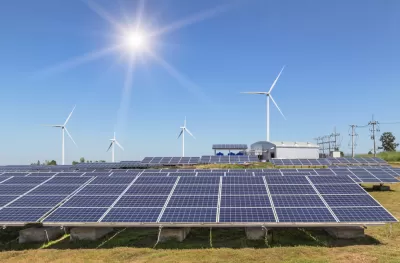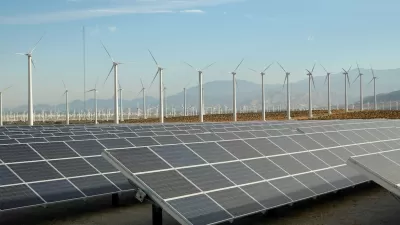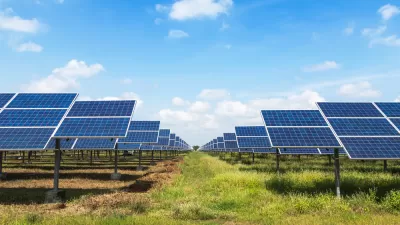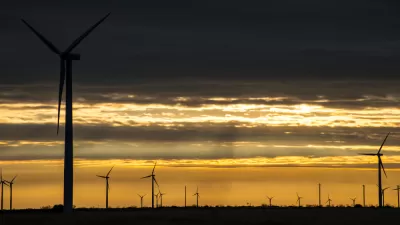As more wind and solar plants get built in remote locations, utilities must figure out how to transport and store energy over increasingly vast distances.

Renewable energy sources are slowly gaining a foothold in the United States, but as Gregory Barber writes, our electric grid isn't quite ready for them. "Since 1889, when the US got its first long-distance power line (it traversed a whopping 14 miles), the grid largely has been set up for energy that’s consumed relatively close to where it is produced." But with renewables like wind and solar requiring vast swaths of space in far-off places, utility companies will have to improve their ability to harness and transport that power to where it's needed.
According to Princeton researchers, meeting national clean energy goals requires increasing the nation's high-voltage transmission capacity by 60 percent. Today, some production facilities are actually forced to shut down when they are producing too much power to transmit over outdated wires.
For plants that are yet to be built, the situation is even worse, because grid constraints mean backers must string new lines, and pay for them, before installing turbines or solar panels. Each year, hundreds of renewable energy projects stall in advanced planning stages due to delays in upgrading transmission lines and the cost of making those upgrades.
Barber describes research being done into 'grid-enhancing tools' that can boost the amount of power that lines can carry and improve flexibility during variable supply and demand periods. But experts say that "[t]echnologies that enhance the existing grid are one part of a much bigger puzzle." Creating a grid that can effectively harness wind and solar energy and meet future demand while preparing for the effects of extreme weather will require a comprehensive plan spanning multiple agencies and users.
FULL STORY: Renewable Energy Is Great—but the Grid Can Slow It Down

Planetizen Federal Action Tracker
A weekly monitor of how Trump’s orders and actions are impacting planners and planning in America.

Congressman Proposes Bill to Rename DC Metro “Trump Train”
The Make Autorail Great Again Act would withhold federal funding to the system until the Washington Metropolitan Area Transit Authority (WMATA), rebrands as the Washington Metropolitan Authority for Greater Access (WMAGA).

DARTSpace Platform Streamlines Dallas TOD Application Process
The Dallas transit agency hopes a shorter permitting timeline will boost transit-oriented development around rail stations.

Renters Now Outnumber Homeowners in Over 200 US Suburbs
High housing costs in city centers and the new-found flexibility offered by remote work are pushing more renters to suburban areas.

The Tiny, Adorable $7,000 Car Turning Japan Onto EVs
The single seat Mibot charges from a regular plug as quickly as an iPad, and is about half the price of an average EV.

Supreme Court Ruling in Pipeline Case Guts Federal Environmental Law
The decision limits the scope of a federal law that mandates extensive environmental impact reviews of energy, infrastructure, and transportation projects.
Urban Design for Planners 1: Software Tools
This six-course series explores essential urban design concepts using open source software and equips planners with the tools they need to participate fully in the urban design process.
Planning for Universal Design
Learn the tools for implementing Universal Design in planning regulations.
Municipality of Princeton
Roanoke Valley-Alleghany Regional Commission
City of Mt Shasta
City of Camden Redevelopment Agency
City of Astoria
Transportation Research & Education Center (TREC) at Portland State University
US High Speed Rail Association
City of Camden Redevelopment Agency
Municipality of Princeton (NJ)





























